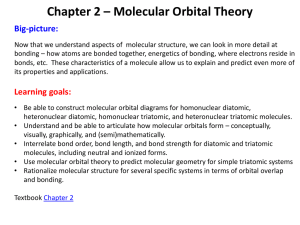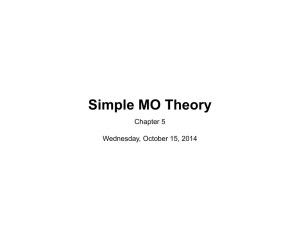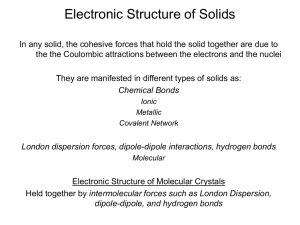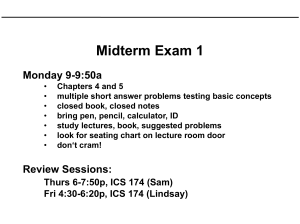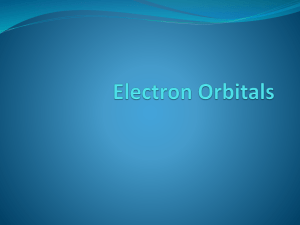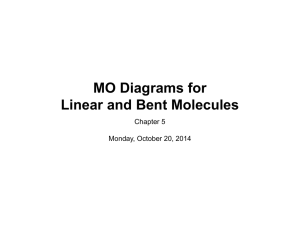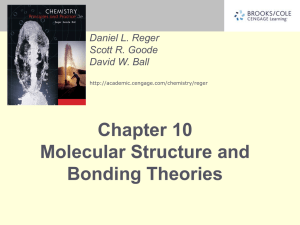Molecular Term Symbols
advertisement
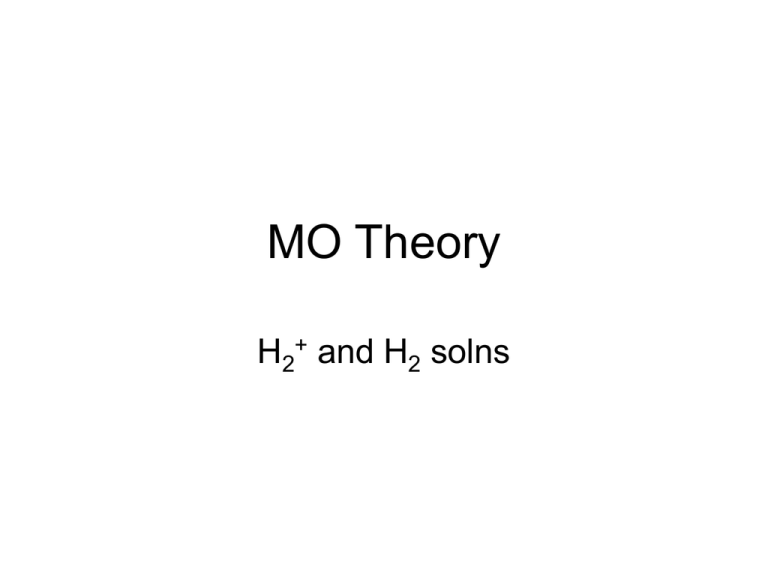
MO Theory H2+ and H2 solns Solutions to Hydrogen Molecule Ion Y2, E2 = -10.16 eV (for H2 ) Y1, E1 = 1.37 eV (for H2) Solutions to Hydrogen Molecule MOs created from combinations of p-orbitals pxA + pxB, pyA + pyB pxA - pxB, pyA - pyB pzA - pzB pzA + pzB Solutions to Hydrogen Molecule px+ px OR py + py px - px OR py - py pz - pz pz + pz represents center of inversion Parity inversion inversion Gerade = symmetric with inversion Ungerade = antisymmetric with inversion MO Energy Level Diagram for Homonuclear Diatomics lone atom s* lone atom p* 2p p 2p s s* 2s 1s s s* s 2s 1s Molecular Term Symbols • ML = S (over all e-) l • l identifies “z-component” of angular momentum of an e• Symbols used to id l |l| 0 1 2 3 4 s p d f g Molecular Term Symbols • Angular momentum about “z-axis” for all electrons is M L L = |ML| Symbol used to id L L 0 1 2 3 4 S P D F G Molecular Term Symbols • Symbol is 2S + 1 L g/u • 2S + 1 is multiplicity as already used for atomic term symbols • g or u identifies overall parity – To determine overall parity, make use of multiplication of symmetric and antisymmetric functions • If the term is a S term, a right superscript of + or – is added to indicate whether the wavefunction is symmetric or antisymmetric with respect to reflection through a plane containing the two nuclei Molecular Term Symbols Remember sigma orbs: From s orbs From pz orbs Remember pi orbs: From px orbs From py orbs Molecular Term Symbols Remember sigma-star orbs: From s orbitals From p orbitals Remember pi-star orbs: From px orbitals From py orbitals Spectroscopy – Selection Rules DL = 0, +1, -1 DS = 0 note S = Ms DS = 0 note W refers to spin-orbit coupling and W=L+S DW = 0, +1, -1 Molecular Term Symbols • Molecular Orbitals not always so “clearcut” • Remember how orbitals change energy as go across PT – Can affect MO energy pattern too MO Energy Level Diagram for Homonuclear Diatomics As you move to the right on PT, 2s and 2p energy gap increases. Early, in the period, then, this permits mixing of 2s and 2pz orbitals. Atkins, Fig 14.30 Essentially LCAOs involving four orbitals are made. The sigma orbitals that we thought of as being made by the 2s orbitals are lowered in E while the sigma orbitals that we thought of as being made by the 2pz orbitals are raised in E. MO Energy Level Diagram for Homonuclear Diatomics (N2 and “before”) lone atom s* lone atom p* 2p Use this diagram for N2 and earlier in PT 2s 1s s p 2p s* s s* s 2s 1s Taking a look at heteronuclear diatomic molecules Taking a look at heteronuclear diatomic molecules MOs of HF Unoccupied, E = -0.124 eV Occupied, E = -0.3523 au E = -0.491 au E = -1.086 au MOs of HF H atom H – F molecule F atom s 1s p 2p s s 2s s 1s Computational Chemistry • Considering complexity of the calculations we’ve been doing, certainly, using computers to do these calcs should be useful Computational Chemistry • For polyatomic molecules can make LCAOs yMO = S ciyi - Yi constitute basis set (computational forms of atomic orbitals) – Use variation theory to find ci – To find structure of molecule, must move nuclei and find MOs find structure with lowest overall energy Computational Chemistry • May “solve” for MOs using ab initio or semiempirical methods – Semi-empirical methods: empirical parameters substituted for some “integrals” to save time in calculations – Ab initio methods: supposedly make no assumptions • NOTE: computational chemistry may determine Energy and some other properties without using quantum chemistry – Such calculations are referred to as molecular mechanics calculations Valence Bond Theory • H2 • Initial approx is y = y1sA(1) y1sB(2) – But, is this a symm or antisymm wavefxn? • So, make LCs – y+ = y1sA(1) y1sB(2) + y1sB(1) y1sA(2) – y- = y1sA(1) y1sB(2) - y1sB(1) y1sA(2) • In this case, turns out that y+ is lower E Valence Bond Theory • Ground state wavefunction would be ybond = [y1sA(1) y1sB(2) + y1sB(1) y1sA(2)][a(1)b(2) – a(2)b(1)] • 2 electrons in overlapping orbitals – with spins paired Remember CH4 • If try to make combinations of the valence s of C with s of H, will be different type of wavefxn, hence diff’t kind of bond than when make combination of a p of C with an s of H • DON’T see any diff in bonding of 4 H’s – – – – Make LCs of valence orbitals on central atom Call these LCs hybrid orbitals Use these hybrid orbitals to make sigma bonds with H Atomic orbitals NOT used to make sigma bonds used to make pi bonds (Huckel method for conjugated) Hybrid Orbitals • Valence s and p orbitals on C hybrids y1 = a12s + a22px + a32py + a42pz y2 = b12s + b22px + b32py + b42pz y3 = c12s + c22px + c32py + c42pz y4 = d12s + d22px + d32py + d42pz • Consider ethyne – Only two hybrids y1 = s + pz and y2 = s – pz – Leftover px and py on one C overlap with px and py on other C Simplification to MO Approach Huckel Approach Symmetry of Molecules Determining Point Groups Special Group? No Yes C∞v , D∞h , Td , Oh , Ih , Th Cn No i C1 No sh No Yes Yes Yes Cs Ci No n sv No Yes Yes No Cn sh Cnv S2n or S2n and i only, collinear with highest order Cn No Sn Yes nC2 perpendicular to Cn Yes No Cnh Dn No n sd Yes sh Yes Dnh Dnd C2v Character Table C2v E C2 sv(xz) sv’(yz) A1 1 1 1 1 A2 1 1 -1 -1 B1 1 -1 1 -1 B2 1 -1 -1 1 Now go practice!!! Applying Symmetry to MOs Water MOs of Water HOMO-4 a1 Looks like s orbital on O, nbo E = -18.6035 au MOs of Water HOMO-3 from two viewpoints a1 Looks like s orbital on O with constructive interference with c1 - bo E = -0.9127 au MOs of Water HOMO-1 HOMO-2 b2 a1 Looks like combination of p on O along C2 with constructive interference with c1, bo (close to nbo) E = -0.3356 au Looks like combination of p on O (perp to C2, but in plane of molecule) with constructive interference with c2, bo E = -0.4778 au MOs of Water HOMO from two viewpoints b1 Looks like p orbital on O, perpendicular to plane of molecule - nbo E = -0.2603 au MOs of Water LUMO LUMO +1 b2 a1 Looks like combination of p on O along C2 with destructive interference with c1, abo E = -0.0059 au Looks like combination of p on O (perp to C2, but in plane of molecule) with destructive interference with c2, abo E = 0.0828 au Filling Pattern for Water 2b2 (abo) 4a1 (abo) 1b1 (nbo) 3a1 (bo/nbo) 1b2 (bo) 2a1 (bo) 1a1 (nbo) Molecular Spectroscopy • Molecule has a number of motions – Translational, vibrational, rotational, electronic • Sum them to get total energy of molecule • Changes may occur in any of these modes through absorption or emission of energy – Vibrational: IR – Rotational: Microwave – Electronic: UV-Vis CHP 16, 17, 18 of text Statistical Mechanics • Quantum gives you possible energy levels (states) – In a real sample, not all molecules in the same energy level • With statistics and total energy, can predict (on average) how many molecules in each state – Dynamic Equilibrium – Role of Temperature • Can predict macroscopic properties/behavior – Heat capacity, pressure, etc. CHP 19, 20 of text


